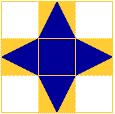I took one of my hand-dyed fat quarters and a commercial fabric fat quarter and, faithfully following the directions, wove them together. I wasn't too sure how wide to cut the strips so decided on 2 1/2".
 These strips, even though they are pretty wide, are slippery suckers and just won't stay put. And that made the weaving a bit of a challenge. But I got there in the end. So, before I started pinning, I did what every good engineer does ... thought it through before jumping into the breach.
These strips, even though they are pretty wide, are slippery suckers and just won't stay put. And that made the weaving a bit of a challenge. But I got there in the end. So, before I started pinning, I did what every good engineer does ... thought it through before jumping into the breach. The most stable part of each fat quarter is the edge that I didn't cut through when I cut the strips. The hand-dyed fabric had 4 cut edges so it didn't matter which side I kept intact. But the commercial fabric FQ still had a selvedge, so I left that one intact.
When I wove them together, I formed a corner where the two un-cut edges came together. That would be the most stable part of the piece and the best place to start pinning. I was working on a table with a smooth surface and every time I put a pin into the woven layers, the strips moved. Even pinning them, starting from the corner formed by the two un-cut edges, didn't help. And every time I moved the piece, things between the pins shifted.
 Now I understand why, in her book, Wendy recommends using water-soluable stabiliser as a foundation. So, the next step is to follow the directions and repin the piece onto waster-soluable stabiliser, which I just happen to have here somewhere ...
Now I understand why, in her book, Wendy recommends using water-soluable stabiliser as a foundation. So, the next step is to follow the directions and repin the piece onto waster-soluable stabiliser, which I just happen to have here somewhere ...







2 comments:
LOLOL Sounds very frustrating Maggie but you've managed to make me want to try weaving with fat quarters... and there I was all innocent just browsing your Blog and now I have another project in my head!! :-) Pennie
What? WHat! follow directions? Where's the fun in that?
Post a Comment